 Image courtesy of Adobe Stock.
Image courtesy of Adobe Stock.
Today, Microsoft releases SharePoint Syntex, the first product from Project Cortex. According to Microsoft, this product uses advanced AI and machine teaching to “amplify human expertise, automate content processing, and transform content into knowledge.”
More specifically, SharePoint Syntex can be integrated with Microsoft’s Information Governance and Records Management package to help organizations using Microsoft 365 “rethink and adapt their approach to govern[ing] data.”
This is an exciting announcement, but you may be wondering: what specific records management (RM) features will SharePoint Syntex include?
Besides a road map of functionalities (below), there has been no official, comprehensive feature list released from Microsoft prior to today. But we’ve gathered insights from Ignite 2020, media releases and the tech community to compile a list of SharePoint Syntex RM capabilities, and some potential limitations to consider, if your organization plans to implement this out-of-the-box product for your records management needs.
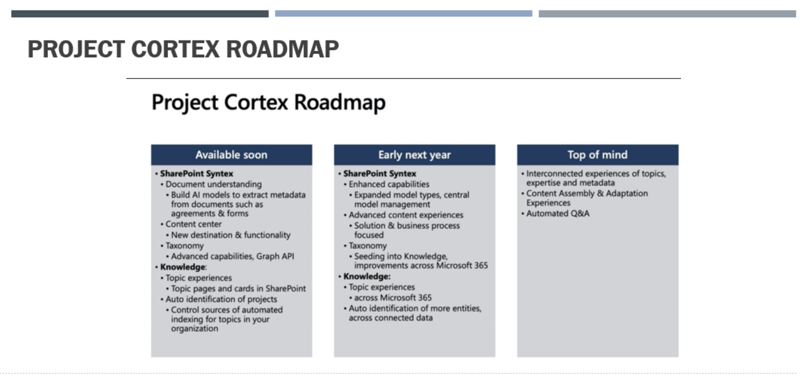 Project Cortex Roadmap shows bullet list of SharePoint Syntex functionalities. Image courtesy of MS Ignite.
Project Cortex Roadmap shows bullet list of SharePoint Syntex functionalities. Image courtesy of MS Ignite.
This article was written right upon product release and will be updated once more information is released on SharePoint Syntex features, capabilities and pricing. Have additional comments or questions? Drop them below!
SharePoint Syntex Records Management Capabilities
1. Content Center
The SharePoint Syntex release will include a new content center where Microsoft 365 users can manage retained content, apply workflows, train classifiers to read/process documents and access integrated analytics.
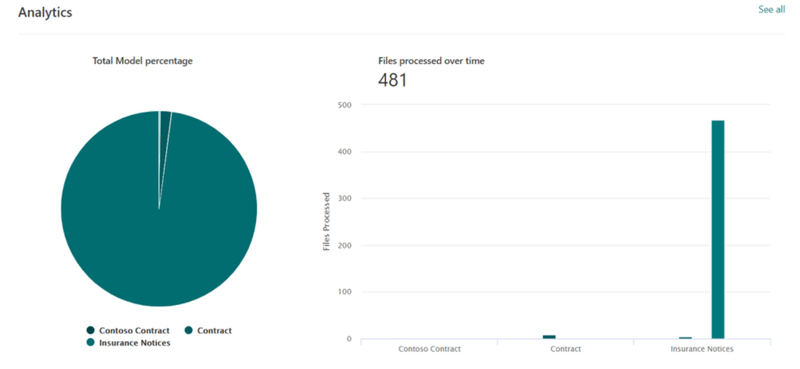 Viewing analytics in SharePoint Syntex content center. Image courtesy of Microsoft.
Viewing analytics in SharePoint Syntex content center. Image courtesy of Microsoft.
2. No-Code AI Model Teaching
SharePoint Syntex will allow users to teach AI to "read a document and extract information... with no-code AI models." This will mainstream AI in the product to process three major types of content: digital images, structured or semi-structured forms, and unstructured documents for auto-application and enhanced OCR capabilities (more on that in section 4).
3. Additional Records Management Capabilities For...
a) OneDrive and SharePoint: version history, ability to mark regulatory records, & more...
As can be seen from the screenshot (below) this release will include enhancements for both SharePoint and OneDrive, including will have enhanced RM capabilities such as version history on desktop, Sensitivity labels, Microsoft 365 Information barriers, and more…
Moreover, users will have the ability to lock and unlock records using record versioning, and can also mark content as regulatory records.
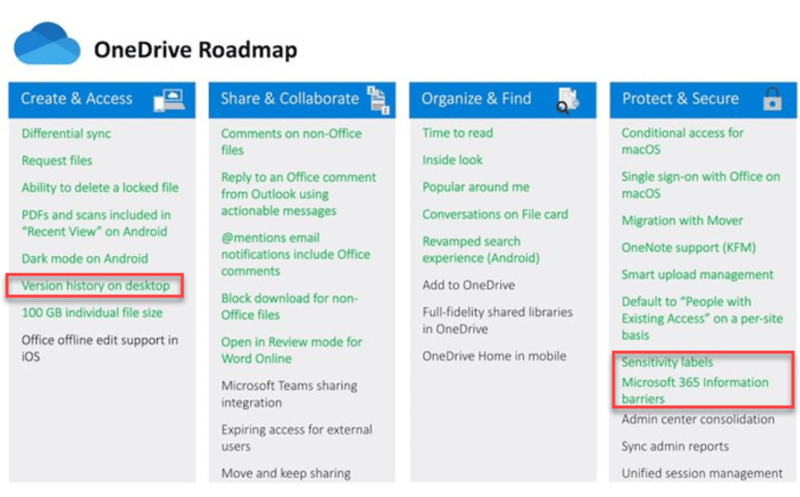 Chart shows features already rolled out for OneDrive in green, and the new release and upcoming features in black. Image courtesy of Microsoft.
Chart shows features already rolled out for OneDrive in green, and the new release and upcoming features in black. Image courtesy of Microsoft.
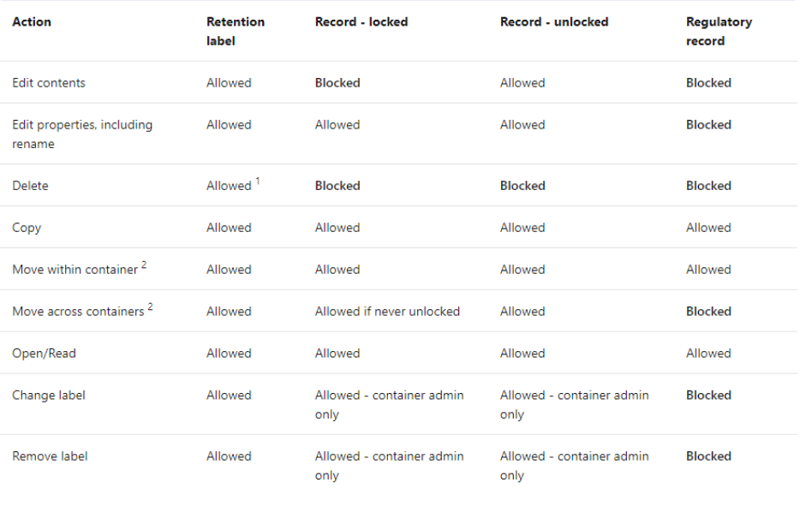 Ability to mark OneDrive and SharePoint content as locked, unlocked, and regulatory records. Image courtesy of Microsoft.
Ability to mark OneDrive and SharePoint content as locked, unlocked, and regulatory records. Image courtesy of Microsoft.
b) Stream, Yammer and Teams (coming soon): retention & search via SharePoint files, label auto-application
This release will include the ability to manage retention and deletion for data from Yammer messages . Users will also be able to configure retention policies, assign retention labels in the compliance center and take advantage of auto-application of labels to apply different retention periods or immutability.
Microsoft Stream will also have an upgrade: being rebuilt to integrate with applications across M365 to easily create, share, and search for videos.
Upcoming capabilities for Teams (coming soon) will include a recap with the meeting records, transcript, shared files, etc. automatically created in Teams, available in the Outlook calendar event and automatically retained into OneDrive and SharePoint for easy access and sharing with external participants.
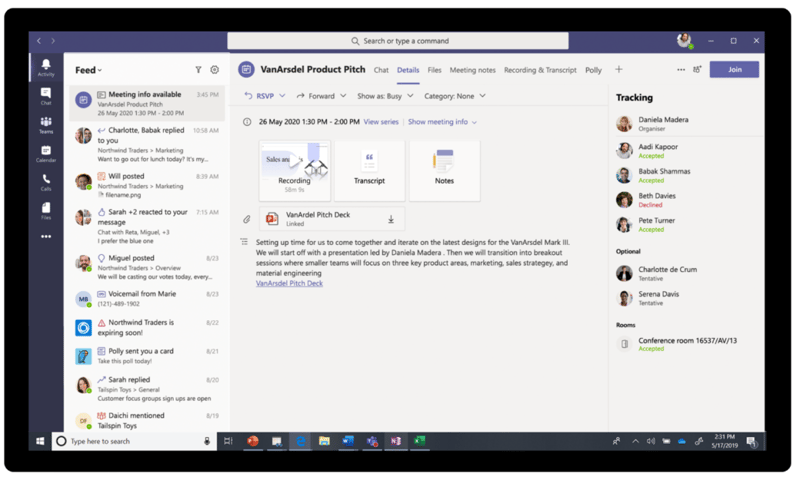 Structured and unstructured data from Teams meetings will be automatically created in Teams and stored in Microsoft 365. Image courtesy of Microsoft.
Structured and unstructured data from Teams meetings will be automatically created in Teams and stored in Microsoft 365. Image courtesy of Microsoft.
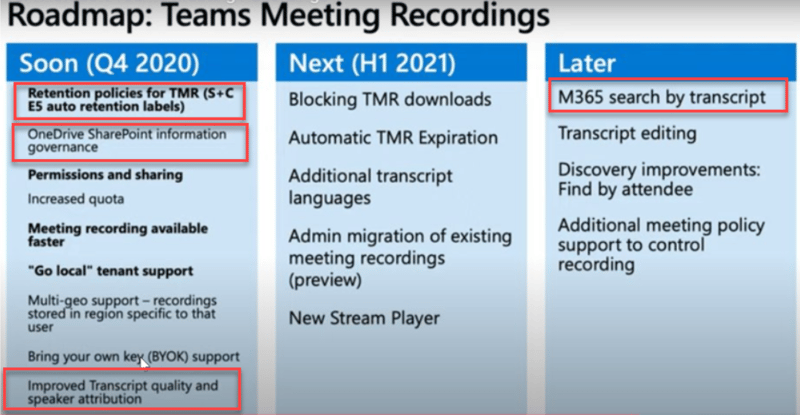 Project Cortex Roadmap shows bullet list of SharePoint Syntex functionalities. Image courtesy of MS Ignite.
Project Cortex Roadmap shows bullet list of SharePoint Syntex functionalities. Image courtesy of MS Ignite.
3. Optical Character Recognition (OCR)
As stated prior, the teaching model will process digital images, structured or semi-structured forms, and unstructured documents for the following capabilities...
a) Digital Image Processing
SharePoint Syntex will be able to automatically tag images and recognize convert extracted handwritten text into tags for enhanced image search and processing.
b) Document Understanding
Users will be able teach SharePoint Syntex to read content so the models can automatically suggest or create metadata, apply workflows, and automatically attach compliance labels. Users can publish and update their models to any library through the SharePoint Syntex content center, and once files are classified by the Document Understanding model, it will set the sensitivity and retention labels so users don’t have to wait for a scan to set it.
 Metadata extraction using SharePoint Syntex document understanding. Image courtesy of Microsoft.
Metadata extraction using SharePoint Syntex document understanding. Image courtesy of Microsoft.
c) Form Processing
SharePoint Syntex will also include a form processing engine, that once again will use AI without requiring coding for automatic recognition and extraction of common values from semi structured or structured documents (dates, names, figures, etc.)
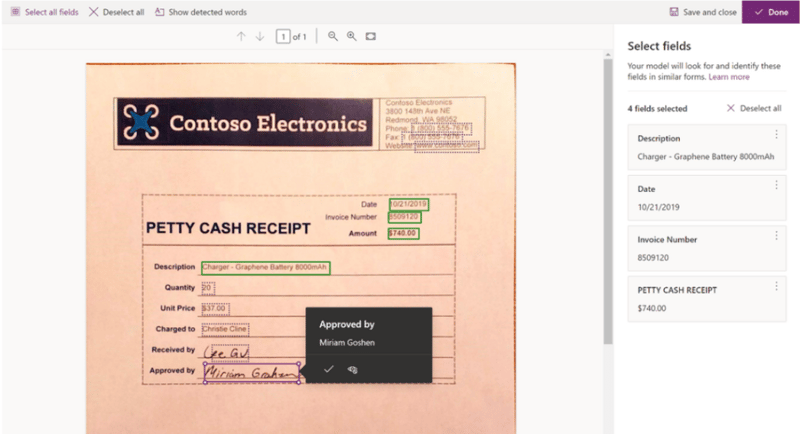 Form processing in SharePoint Syntex. Image courtesy of Microsoft.
Form processing in SharePoint Syntex. Image courtesy of Microsoft.
4. Cross Platform Search and Discovery with Additional Connectors
Microsoft has added capabilities in their Microsoft Graph to integrate more connect connectors (such as file shares, Azure SQL, and other third party sources). The content from these connectors (full list here) will be searchable and usable throughout Microsoft 365.
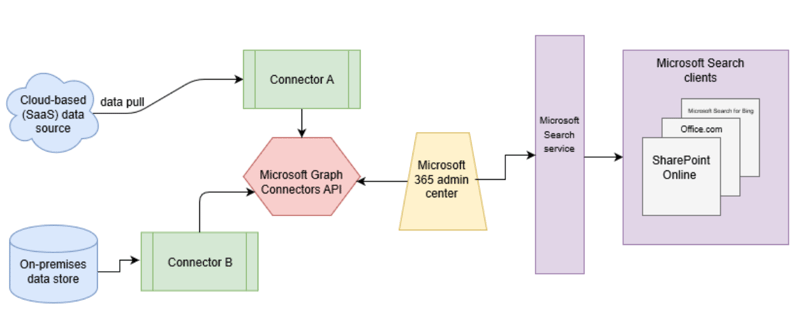
This architectural diagram of the Microsoft Graph platform shows how connector content flows through content indexing to user results in Microsoft Search clients.
These new capabilities are no doubt, an upgrade to the records management experience for Microsoft 365 users! But searching through, we also spotted some potential gaps and questions that are important to consider...
Potential Limitations with SharePoint Syntex
1. Changes blocked once retention label has been applied
According to technical documentation released by Microsoft, once a regulatory record has been applied to content, not even a global administrator can remove this label. Restrictions also include inability to shorten a retention, and these labels are not support by the auto-labeling policies.
Being manually applied leaves room for human error, and if a mistake is made then is cannot be unmade with regulatory records.
2. Connector connect limited to search within custom verticals; individual implementation
While there will be 25+ additional connectors, they will not be ready for use upon SharePoint Syntex purchase. Implementation of each connector must happen through the listed company partners or by your organization. In addition, the RM capabilities listed above (label auto-application, workflows, retention into M365) will not be applied to connector content. Based on current knowledge, connectors will only enable searching of content from external systems. Content from each external system will be displayed in its own location (can only be searched within custom verticals), rather than an all-results view.3. SharePoint Syntex not yet available for GCC or GCC High
These capabilities are not yet available for Microsoft 365 Government Community users, the levels that "support the Federal Risk and Authorization Management Program (FedRAMP) accreditation at a Moderate Impact level" for government compliant records management.
4. Pricing
To the organizations who have invested in Microsoft 365, SharePoint Syntex will be an additional $5 cost per-user, per-month with an annual commitment. This could prove costlier than a third-party add-on that provides fully compliant, end-to-end capabilities and connectors already in-place.
5. Question around data residency
The following remains unclear until we hop in and scope for ourselves will data residency at-rest and in-transit be considered so M365 users outside of the US will also ensure RM compliance?
Conclusion
The release of Project Syntex is an exciting one, bringing new AI teaching models and enhanced RM capabilities to Microsoft 365. Microsoft syntex looks promising for bringing organizations a step closer to implementing a fully compliant, end-to-end RM solution out-of-box.
But before implementation, it’s important to consider certain items such as inability to update content once a locked/regulatory label has been (manually) applied, limitations around the data connectors, and additional costs. It could prove more cost efficient for organizations to pair the E3 or E5 they have already invested in with a third party RM add-on that provides end-to-end records management capabilities and ensures compliance.
Want to compare? We’ve created a Microsoft 365 comparison chart to show E3, and E5 RM capabilities and costs out-of-the-box, versus when they have been paired with powerful add-on Collabspace (hint: they are stronger and less costly when paired!). Download it for free below, or check out our brochures about our on-premises and cloud-based records management solutions:

![]()
![]()
Have thoughts, comments, or questions on this topic? Leave your comments down below or contact us!
To read more like this, check out our articles about SharePoint Content Types, modal dialogs, or information architecture!







